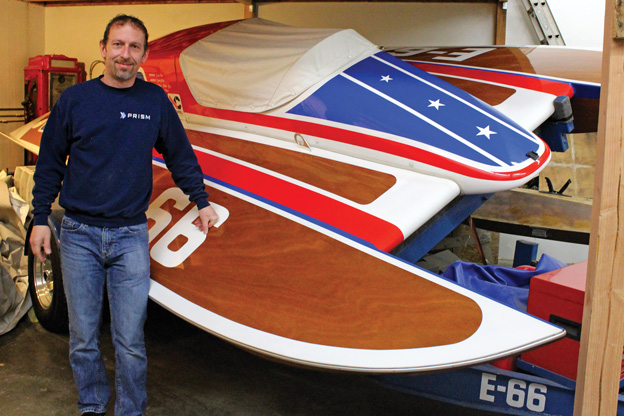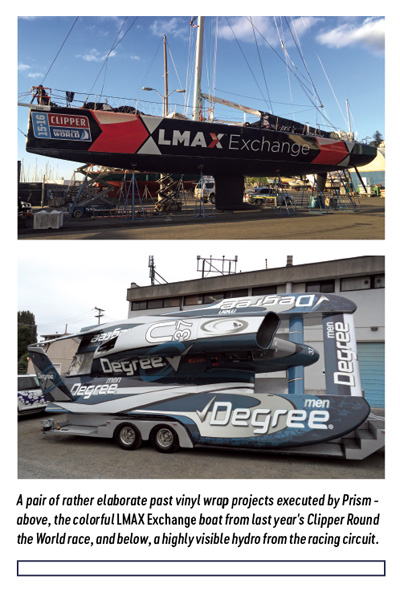“The future belongs to those who
believe in the beauty of their dreams.”
-Eleanor Roosevelt
In many ways, March in the Pacific Northwest is a month of yearning. We stand, one foot in the gray of winter and the other in the promise of spring, eager to get on the water without our foulies again. March is a generally a good month to get those boat projects under control in time for the summer, and for many, the approaching spring means haul outs and paint. But for those who desire to depart from the traditional route, vinyl wrapping remains an alluring option.
Perhaps the stunning graphics on the hulls of the clippers from the Clipper Around the World race got your attention from last year when they were docked at Pier 66 in Seattle? Those colors and detail are only possible with graphics inked onto a vinyl wrap. Graphics printed onto vinyl wraps are not exactly new, for we see them in many other aspects of our lives. Sports cars have been using vinyl for decades, for example. But, like with many things, the maritime industry is a little more conservative, more hesitant to take a gamble. It makes some degree of sense, for a skipper cannot simply pull over on the water when something goes awry. Mariners like to see how things play out first, for ideas to earn their sea legs at somebody else’s dime before putting their hard-earned chips on the table.
But the reviews are in; vinyl is a viable alternative to topside paint. To investigate further, we visited Brad Cole of Prism Graphics in south Seattle’s industrial district to learn more about the eye-catching world of vinyl wraps. Their warehouse was quietly bustling with employees pouring over color schemes and rendering graphics on computers as we met with Cole at his upstairs desk for a chat. The takeaway? If you haven’t thought about wrapping as an option, you probably should.
 Q: So, boats aren’t all you do here, correct? How much of your business is boats?
Q: So, boats aren’t all you do here, correct? How much of your business is boats?
The number of boat projects depends on the time of year. During the summertime, it’s probably about 50-50 boats to other projects. In the winter, it’s probably 25% to 75% boats to other projects.
Q: Nice! For the unconverted, what are some benefits to wrapping?
There’s plenty of benefits to vinyl wrapping. Wraps can be done quickly; I can have a boat wrapped in three days. A typical wrap lasts eight to ten years, about as long as an Awlgrip paint job for the most part. The cost can be up to a quarter of that of a normal painting. Most of my wrap jobs are $4,000 to $6,000, while a paint job for the same yacht can be $20,000 to $30,000. You can often even wrap your boat twice for the cost of one paint job. So there are some benefits.
Q: Isn’t vinyl vulnerable to chipping or chaffing?
The vulnerability of vinyl is that it is softer than paint, so you have to be a little more careful about running into the dock. I always recommend you put the soft covers over your rubber fenders to keep the fenders from rubbing constantly. But the material is pretty durable, I’ve seen people hit the dock pretty hard and only need a buff out, nothing needed to be replaced.
Q: So a client approaches you and they are interested in vinyl wrapping their boat for the first time. Where do you go from there?
Firstly, we have different client bases and job requests. We have my commercial clients for which I do vehicle wraps and commercial signage, we have our boat-name customers for whom we do that for, and we have our boat wrap customers. Almost always we’ll go to the boat and see what we’re looking at, take some measurements, and make sure what we decide on is what the customer really wants and will be happy with. We take pictures and measurements and then sit down around the customer to go through the design, if we’re designing, or pick colors if we’re doing a mono-color wrap. We’ll produce computer renditions so the customer can see what it’s going to look like. Even if it’s a full wrap of one color, I’ll try to get a good side photo of the boat and to create a Photoshop mock-up of the colors.
There are many variables in making a successful wrap. There may be obstacles, for example, transom graphics can be affected by lights, ladders, and doors. We have to incorporate those kinds of things into the design. That’s the main reason we like to go to the boat ourselves, so we know exactly what we’re dealing with. Then we’ll work with the customer on the design, and once we have a design we’ll produce it.
 The customer can install the actual wrap themselves or we can. Most of the time, we are going back to the boat and installing it so the customer doesn’t have to do anything. If it’s a full wrap, we have to coordinate a haul out, or coordinate them into our shop if it’s trailerable. A full wrap will typically take anywhere between one and four days, depending on size of boat. Transom graphics can be done in an hour.
The customer can install the actual wrap themselves or we can. Most of the time, we are going back to the boat and installing it so the customer doesn’t have to do anything. If it’s a full wrap, we have to coordinate a haul out, or coordinate them into our shop if it’s trailerable. A full wrap will typically take anywhere between one and four days, depending on size of boat. Transom graphics can be done in an hour.
Q: Sounds like once you have your ducks in a row, the process is pretty quick?
Yes, the actual producing of the graphics and getting the wrap on the boat can be done within a day or two. The lengthy process is deciding what the customer wants and working back and forth. Everything we do is custom designed from scratch. Customers always ask me how long it takes to get done, but once the customer has what they want, we can usually be done in under a week. The decision process on the other hand can take a week to a month, so there’s that to consider.
Q: Sounds like a measure a hundred times and cut once kind of thing?
Exactly. We’re good enough so we know exactly what we’re looking for when we go to the boat so the actual measurements are easy, but even when a customer sends pictures and measurements by themselves, very often I go to the boat to confirm those myself. We’ve just run into too many issues where a customer doesn’t take into consideration a light or a stanchion or a ladder or a bend in the hull or a break in the fiberglass.
Q: Is there a lot of preparation to the hull base before applying the wrap?
Not a whole lot, we basically just wash and wipe it down. We wipe the boat down with alcohol, sometimes acetone, to get contaminates off. We sometimes need to remove hardware and things like that before applying, but besides that, there’s not a whole lot of prep work that you have to do.
Q: So clients arrange a boatyard pull and you go to them, or do they get the boat to you?
I can do either. I work extensively with CSR Marine, so if I need to do it, I coordinate with them. Boat owners can also coordinate their own haul out anywhere they’d like to go. Usually the boat owner coordinates the haul out and then I just come to do my job.
Q: Is there an ideal size for wrapping where it’s cost effective?
The wrap material comes in 60-inch wide and 150-foot long rolls, so depending on the freeboard of the boat (if it’s 60 inches or less) I can wrap the boat in one roll, which is cheaper. With some of the smaller boats, like ski boats when they have 30 inches or less freeboard, I can cut the material in half and save quite a bit of money on material because I can get both sides out of one piece.
Q: How about all those crazy designs? The art potential seems like a really cool benefit to vinyl wrapping.
Yes, there are about 200 solid colors from the manufacturer, and we have a large format digital printer than can print just about any design or photograph. We can laminate over the print and wrap that. There are pretty much endless possibilities.